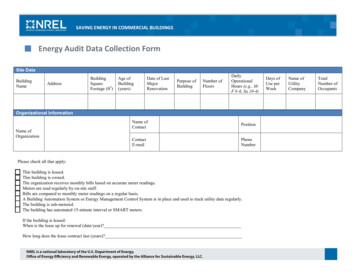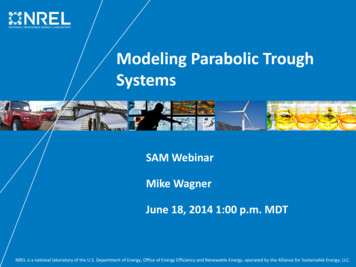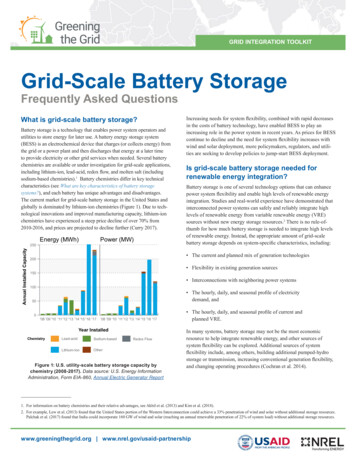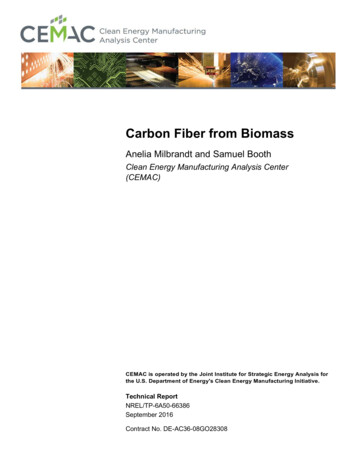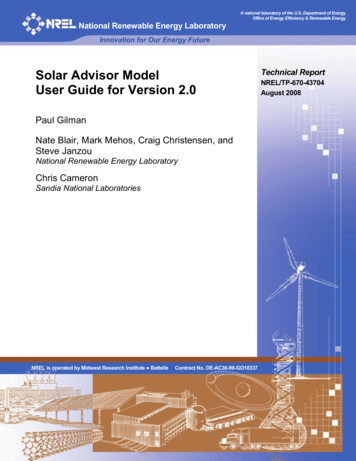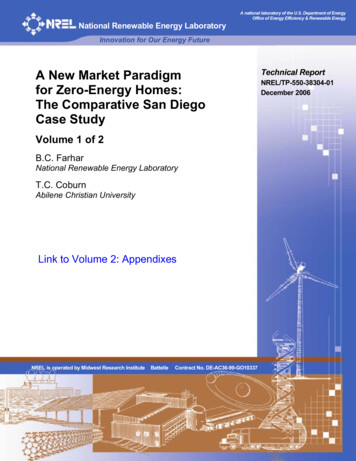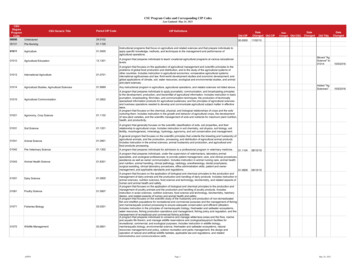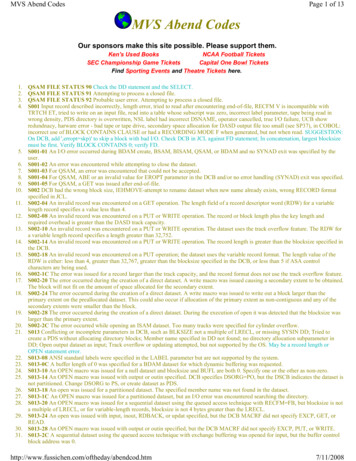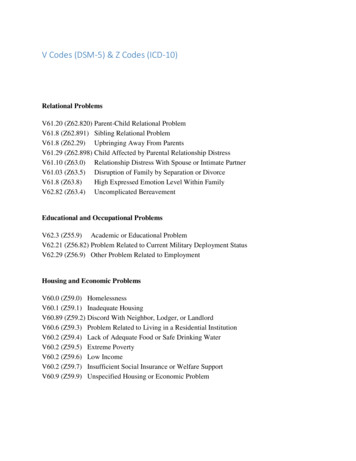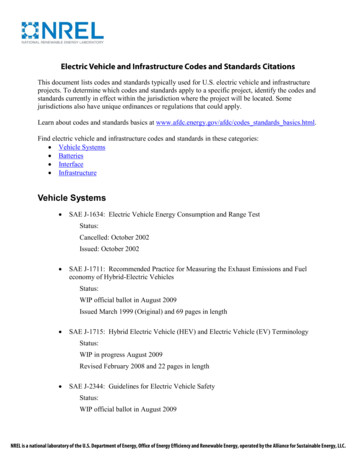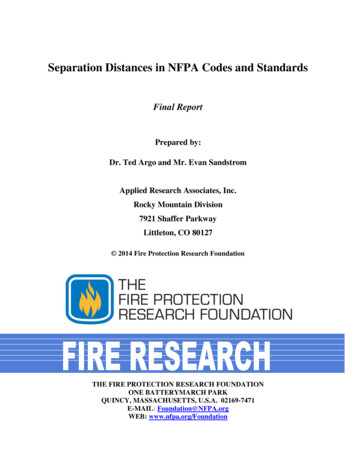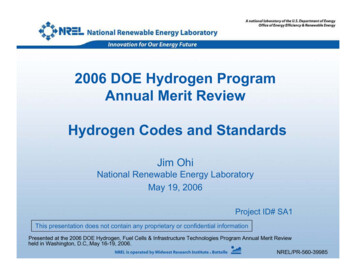
Transcription
2006 DOE Hydrogen ProgramAnnual Merit ReviewHydrogen Codes and StandardsJim OhiNational Renewable Energy LaboratoryMay 19, 2006Project ID# SA1This presentation does not contain any proprietary or confidential informationPresented at the 2006 DOE Hydrogen, Fuel Cells & Infrastructure Technologies Program Annual Merit Reviewheld in Washington, D.C,.May 16-19, 2006.NREL/PR-560-39985
Disclaimer and Government LicenseThis work has been authored by Midwest Research Institute (MRI) under Contract No. DE-AC36-99GO10337 with the U.S.Department of Energy (the “DOE”). The United States Government (the “Government”) retains and the publisher, by acceptingthe work for publication, acknowledges that the Government retains a non-exclusive, paid-up, irrevocable, worldwide license topublish or reproduce the published form of this work, or allow others to do so, for Government purposes.Neither MRI, the DOE, the Government, nor any other agency thereof, nor any of their employees, makes any warranty, expressor implied, or assumes any liability or responsibility for the accuracy, completeness, or usefulness of any information, apparatus,product, or process disclosed, or represents that its use would not infringe any privately owned rights. Reference herein to anyspecific commercial product, process, or service by trade name, trademark, manufacturer, or otherwise does not constitute orimply its endorsement, recommendation, or favoring by the Government or any agency thereof. The views and opinions of theauthors and/or presenters expressed herein do not necessarily state or reflect those of MRI, the DOE, the Government, or anyagency thereof.
OverviewTimeline Project start date: 10-1-05 Project end date: 9-30-06 Percent complete: 50Budget Total project funding– DOE share: 1.26M– Contractor share: 22K Funding received in FY05: 2.0M Funding for FY06: 1.28MBarriers Codes and Standards Barriers addressed– Consensus national agenda on codes andstandards (J,A,B,D,L)– Limited DOE role in development of ISOstandards and inadequate representation bygovernment and industry at internationalforums (F,G,H,I,K)– Current large footprint requirement forhydrogen fueling stations (P,N,M)Partners National H2/Fuel Cells Codes and StandardsCoordinating Committee FreedomCAR-Fuel Partnership C&S TechnicalTeam North American H2 Fuel Quality Team
Objectives Strengthen and implement consensus national agenda on domesticand international codes and standards for hydrogen systems incommercial, residential, and transportation applications Facilitate harmonization of requirements for hydrogen applicationsbased on consensus R&D Enhance DOE’s role in development of ISO and other internationalstandards and strengthen representation by government and industryat international forums Integrate codes and standards activities from R&D to precommercialization
Approach: Program StructureNREL Focus Highlighted
Approach Strengthen and implement unified national agenda for codes andstandards– National templates adopted by consensus of SDO/CDOs accelerate development of priority standards designate and support lead SDO/CDOs facilitate access to standards/model codes through ANSI website– Coordinate national/international codes and standards activities National H2/Fuel Cells Codes and Standards Coordinating Committee Coordinate and conduct R&D through Codes and Standards TechTeam R&D Roadmap– Fuel-Vehicle Interface hydrogen fuel quality specifications performance-based component testing and validation Harmonize requirements in domestic and international standards– Work with and coordinate key participants, e.g., ICC-NFPA, ISO TC197SAE, IEC TC105-CSA, CGA-CSA/US TAGs
Technical Accomplishments/Progress Unified national agenda for codes and standards– Strengthened national consensus through National H2-FC C&SCoordinating Committee created in FY05 by DOE, NHA, USFCC thatincludes all key SDOs, CDOs, state/federal agencies, other stakeholders– Negotiated contracts with all key SDO/CDO to develop essential standardsand model codes under significant budget constraints R&D to develop defensible standards for hydrogen systems– Codes and Standards Tech Team R&D Roadmap implementation completed international guidelines for hydrogen fuel quality (ISO DTS14687-2) prepared R&D/test plan for hydrogen fuel quality facilitate development of better risk-informed codes and standards (with SNL) Harmonize requirements in domestic and international standards– member of ISO/TC197 WG 12 to prepare hydrogen fuel qualityspecification– member U.S. Technical Advisory Group, ISO/TC197, HydrogenTechnologies– work with CGA and CSA to coordinate ISO/TC197 and IEC/TC105– conduct semi-annual ISO-IEC “TAG-Team” meetings with NHA, USFCC
Technical Accomplishments/Progress:Unified National Agenda for Codes and Standards Integrated ANSI Hydrogen (and Fuel Cells) Codes & Standards Portal(http://hcsp.ansi.org), DOE Hydrogen and Fuel Cells Codes andStandards Matrix and Database (www.fuelcellstandards.com), andHydrogen and Fuel Cell Safety Report (www.hydrogensafety.info)– provides comprehensive information regarding published codes andstandards documents, national and international codes and standardsunder development, and information for members of the NHFC4 andother stakeholders ASME completed Design Margin Guidelines for High-PressureHydrogen Tanks and Properties for Composite Materials in HydrogenService and will develop standards for high-pressure hydrogen tanksfor stationary applications and use of non-steel metals and compositematerials for high-pressure hydrogen storage tanks
Technical Accomplishments/Progress:Unified National Agenda for Codes and Standards Compressed Gas Association (CGA), Administrator for U.S.Technical Advisory Group (TAG) for ISO TC197 (HydrogenTechnologies) developed website to facilitate consensus positions onproposed international standards, balloting on specific TAG issuesCSA-America developing performance-based requirements forgaseous hydrogen dispenser systems standards in collaboration withSAE Industry Panel on Hydrogen Codes (HIPOC) established– neutral forum to develop and submit hydrogen-related code provisions toICC and NFPA and harmonize provisions in ICC and NFPA codes andstandards Transition SDO/CDO contracts to DOE-GO competitive solicitation
Technical Accomplishments/Progress:Unified National Agenda for Codes and Standards
Technical Accomplishments/Progress:Unified National Agenda for Codes and Standards
Technical Accomplishments/Progress:Unified National Agenda for Codes and Standards
Technical Accomplishments/Progress:Codes and Standards R&D Roadmap ImplementationFueling Station-Vehicle Interface Hydrogen Quality: Nozzle to Fuel CellFeedback StrategiesDispenser Protocol andTesting (70 Mpa)Fueling ComponentsStation GroundingIntegrated Systems Design
Technical Accomplishments/Progress:Fuel Quality – ISO TS14687-2 Table of CharacteristicsTable 1 — Directory of limiting characteristicsType IType IIGrade DGrade DHydrogen fuel index(minimum, %) a, b99,9999,99Para-hydrogen(minimum, %)NS95,0Characteristics(assay)Non-hydrogen constituents (maximum content)Laboratory Test Methods to ConsiderDimensions in micromoles per mole unless otherwise statedTotal gases Error!Reference source notfound.100100Water (H2O)55ASTM D6348, D5454, (D1946 & D5466)gJIS K0225Total hydrocarbons c(C1 basis)22EPA T012, T015, ASTM (D1946 & D5466) g, D6968, JISK0114Oxygen (O2)55ASTM (D1946 & D5466) g, JIS K0225Helium (He), Nitrogen(N2), Argon (Ar)100100ASTM (D1946 & D5466) g, JIS K0114Carbon dioxide (CO2)22ASTM (D1946 & D5466)g, JIS K 0114, K 0123Carbon monoxide (CO)0,20,2EPA 25C, ASTM (D1946 & D5466)g,JIS K 0114, K 0123Total sulfur compounds d0,004 f0,004 fASTM (D1946 & D5466) g, D5504, JIS K 0127Formaldehyde (HCHO)0,010,01EPA Method 11, NIOSH 2541, EPA T015, ASTM (D1946 &D5466) g, JIS K 0114, K 0124, K 0123Formic acid (HCOOH)0,2 f0,2 fASTM (D1946 & D5466) g, JIS K 0123, K 0127Ammonia (NH3)0,1 f0,1 fASTM (D1946 & D5466) g, EPA T015, JIS K 0127Total halogenatedCompounds0,050,05EPA 200.7, JIS K101Max Particulates Size e10 µm10 µmSCAQMD Method 301-91Max ParticulatesConcentration e1 µg/L @ NTP1 µg/L @ NTPGravimetric (EPA IO 3.1)
Technical Accomplishments/Progress:Fuel Quality – R&D/Testing Approach DefinedCollect, evaluate, and report assemblage of data and informationRecommend H2 fuel quality specificationsFuel cell vehicle performancecharacteristics as a function ofH2 fuel contaminantsFuel cell performancecharacteristics as afunction of H2fuel contaminantsH2 fuel qualitydependence onsuppliers’ processingtechnologyH2 storage mediacharacteristics asa function of H2fuel contaminantsAnalyticalinstrumentationto monitor H2fuel quality- Assessment of H2fuel quality- BOP issues- Correlation of modelwith vehicle- Vehicle fuel cell preand post test- Single contaminant/level - Source of H2 fuel- Single contaminant/level - Determine- Contaminant/levelproduction- Contaminant/levelanalyticalcombinations- Method of cleanupcombinationsparameters and- Test conditions- Alternative processes,- Choices of materialsconstraints for- operationalmethods for cleanup- Long duration testskey contaminants- physical- Technical, economic- Cyclic and transient- Identify/analyze- Long duration testsfuel-quality driverstestsalternative methods- Transient tests- Operating conditions- Conduct field- Alternate catalyststestsand materialsModeling to support understanding of failure mechanisms, production/supply, material development, vehicle systems
Technical Accomplishments/Progress:Fuel Quality – Effects of Non-hydrogen Constituents onPEM Fuel Cells and Vehicle Systems DefinedSpeciesFC StackBOPStorageInert gasses(Helium, Argon,Nitrogen)H2 dilution effect,affects systemefficiencyWill affectpurging rateand blowersBelieved to affectcycle life of reactivestorage mediaHydrocarbonsAromatics, acids,aldehydes, etc.,degradeperformanceUnknownMay affect cycle life ofreactive storagemediaOxygenTolerant to 500 ppmMay form iceBelieved to affectcycle life of reactivestorage mediaCarbonMonoxideReacts, degradesperformance(reversible)No effectBelieved to affectcycle life of reactivestorage mediaCarbon DioxideTolerant at 100ppm – limited COback shiftingNo effectBelieved to affectcycle life of reactivestorage mediaSource: SAE
HighTechnical Accomplishments/Progress:Fuel Quality – Specification Tradeoffs DefinedImpact on Fuel CellSulfur speciesAmmoniaCarbon MonoxideAromatic & Aliphatic HCsOxygenLowCarbon DioxideMethaneNitrogenLowSource: Shell HydrogenDifficulty to Attain and Verify LevelHeliumHigh
Technical Accomplishments/Progress:Hydrogen Purification Drivers (PSA)SpeciesHelium (He)AdsorptionForceZeroISO TC 197WG 12(14687)Draft SpecATRMol %PurificationRatio for ATRSMRMol %PurificationRatio for SMR100 ppm500 ppm5500 ppm5OVERALLEFFECTNOT POSSIBLE(total inert)Hydrogen (H2)Weak99.99%40-45%Oxygen (O2) 5 ppm50 ppm10--Impacts PSA recovery& Capital CostArgon (Ar) 100 ppm500 ppm5500 ppm5Impacts PSA recovery& Capital Cost34-38%38001000 ppm10Impacts PSA recovery& Capital Cost0.2 ppm0.1 -1 %500000.1-4%200000Impacts PSA recovery& Capital Cost2 ppm0.5 – 2%100000.5 – 3%15000Impacts PSA recovery& Capital CostImpacts PSA recovery& Capital Cost75-80%(total inert)Nitrogen (N2) 100 ppm(total inert)CarbonMonoxide (CO) Methane (CH4)(incl THC)Carbon Dioxide(CO2) 2 ppm15-17%8500015 -18%90000Relatively easier toremoveTotal HC’s 2 ppm0.1 %5000.5%2500Relatively easier toremove(incl CH4)AmmoniaStrong0.1 ppmTotal SulfurStrong0.004 ppmRelatively easier toremoveHalogenatesStrong0.05 ppmRelatively easier toremoveWater (H2O)Strong5 ppmSource: ChevronLow ppmDew PointLow ppmDew PointRelatively easier toremoveRelatively easier toremove
Technical Accomplishments/Progress:Fuel Quality – Critical Constituents Defined To date, the North American team has identified the following ascritical constituents around which near-term R&D and testing should befocused:– CO– S compounds– He– CH4 and inerts– NH3– Particulate Matter ( 10µ diameter)This list may change and other critical constituents may be identifiedas R&D and testing proceed
Technical Accomplishments/Progress:Fuel Quality – 5-year R&D/Testing Plan Defined2006Topic of InvestigationI. Consensus Testing Strategy200720082009A. Fuel cell-OEMs/fuel providers select ncritical species from Table 1 based on keytechnical/economic driversB. Develop R&D/test plan with WG12C. Coordinate activities, revise plan annuallyD. Derive optimal balance bet. fuel cellperformance and fuel costII. Fuel Cell Tests ('standard' MEA)A. Conduct failure mechanism tests w/reconcn. at const. load, RH, T & P with criticalconstituents (CO, H2S, etc.)B. Conduct long-term tests (const. physicalconditions) and const. & variable loads withcritical constituents (CO, H2S, etc.)C. Conduct tests with selected combinationsof critical constituents (CO, H2S, etc.) andconcentrationsDetermine mechanismAging/constloadIdentify regenerationalternativesAging/variable loadDetermine mechanismsIdentify regenerationalternativesOperations with limited contaminants andlimits on conditions (load,SD/SU)D. Conduct "Simulated Drive Cycle" tests withH 2 critical constituents as fuelAlternatematerialsAgingw/regenAlternative materials use (lowcat. loading, etc.)Commercial MaterialsOperations with 'H2 Fuel' & typicalconditionsE. Investigate performance/cost trade offs re:critical constituentsIII. H2 Fuel Provider IntegrationA. Define H2 fuel quality variations based oncurrent cleanup procedures (relative to criticalconstituent limits)B. Define contaminant species/ concentrationvariations as a function of planned HC. Investigate H2 cleanup alternativescommensurate with fuel cell testsD. Conduct cost trade-offs re: criticalconstituents2sourcesIV. Analytical Protocol/InstrumentationA. Evaluate adequacy of Table 1 info., setpriorities based on IAB. Modify ASTM standards to measure criticalconstituents as neededC
NREL/PR-560-39985. Disclaimer and Government License. This work has been authored by Midwest Research Institute (MRI) under Contract No. DE-AC36-99GO10337 with the U.S. Department of Energy (the “DOE”). The United States Government (the “Government”) retains and the publisher, by accepting the work for publication, acknowledges that the Government retains a non-exclusive, paid-up .
